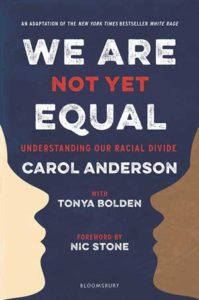We Are Not Yet Equal: Understanding Our Racial Divide
Reviewed by Anna Carolyn McCormally
May 1, 2019
 By Carol Anderson and Tonya Bolden. Bloomsbury YA, 2018. 288 pages. $19.99/hardcover; $13.99/eBook. Recommended for ages 12–18.
By Carol Anderson and Tonya Bolden. Bloomsbury YA, 2018. 288 pages. $19.99/hardcover; $13.99/eBook. Recommended for ages 12–18.
In her 2016 book White Rage (reviewed in the March 2017 Friends Journal), Carol Anderson gave our national conversation about race a new framework by chronicling the ways in which key moments of progress toward racial equality in the United States have been met, time and time again, with active, systemic backlash. Now in We Are Not Yet Equal: Understanding Our Racial Divide, Anderson writes in tandem with children’s and young adult literature author Tonya Bolden to adapt White Rage for younger readers. Although written for younger readers, this book does not dumb down the subject matter. Photographs, archival clippings, sidebars explaining key federal legislation and court decisions, and a clear narrative style provide an in-depth look at history and context for the current political moment.
I was struck as I read this book by how little I retained (or was ever taught) about Reconstruction, the Great Migration, or the backlash against Brown v. Board of Education. When I learned about these events in history, it was taught as just that: history. The Civil Rights Act passed, and racial equity was achieved. Jim Crow was a distant past, taught as another historical time period to learn about alongside ancient Egyptian, Greek, and Roman civilizations.
By beginning with the Civil War and working forward in time to the present, We Are Not Yet Equal shows how history is not a string of discrete moments in time but builds upon itself: how Black Codes enforced during Reconstruction made it difficult for many to chase the promise of economic opportunity in the North during the Great Migration; how between 1874 and 1888 the Supreme Court asserted literal readings of the Thirteenth, Fourteenth, and Fifteenth Amendments that severely limited the scope of the rights and protections they guaranteed to Black people; how the shutdown of public school systems in many cities and states over integration meant decades of lost educational opportunity that rippled through generations; how because of this steady, predictable backlash against what we think about as grand, noble steps advancing racial equity (the Civil Rights Act, integration, and even emancipation), there is still so much work to be done on both the level of policy and the level of ideology in the United States.
If you have a young adult who is on the younger side of the age range, I would recommend reading this book alongside, one chapter at a time. Adult readers who haven’t read White Rage will still benefit from having their solid foundation shaken while reading this young adult book. Use this book to inform conversation about white privilege, affirmative action, and Black Lives Matter. Be aware; this book does its duty to the truth and does not skip over violent moments in U.S. history: lynching, rape, murder, and the realities of chattel slavery are hard to read about no matter how they are presented. We Are Not Yet Equal does not sensationalize them or treat violence gratuitously; it is simply honest.



Comments on Friendsjournal.org may be used in the Forum of the print magazine and may be edited for length and clarity.